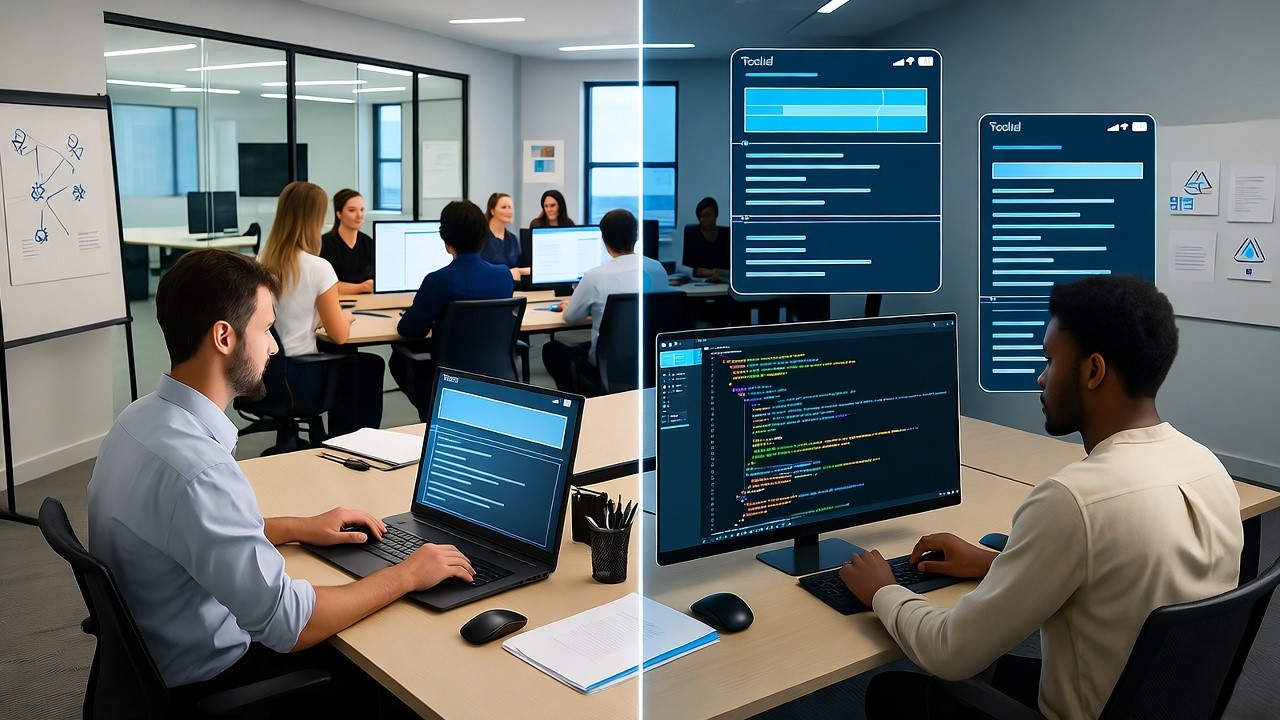Key takeaways: Pseudocode Creator using Niral AI
- Design → pseudocode → code is a clearer, more efficient path.
- AI tools are now capable of this with good design system discipline.
- The pseudocode layer — though often overlooked — is the glue that improves alignment, reduces rework, and speeds delivery.
- For teams using React/Vue/Tailwind or similar stacks, adopting a tool like Niral provides practical benefits.
How to Create Pseudocode from Figma Using AI, From a Design-to-Code Company’s View
What if you could open a design file in Figma, hit a button, and immediately get clean pseudocode (and even production-ready frontend code) that aligns with your product architecture? In the U.S., where time-to-market matters and design-engineering handoffs are often a bottleneck, this shift matters.
I’ve spent over a decade building UI/UX tools for startups and enterprise SaaS companies, guiding teams through design-to-code handovers in dozens of projects. Today I write to you as the founder of Niral, a U.S.-based platform that converts Figma files into frontend code, and we’re stepping into pseudocode creation from Figma via AI as the next frontier. In this blog I’ll explore the what, why, how, and best practices of turning design files into pseudocode and then real code, comparing tools, workflow changes, and practical tips.
You can use AI-powered tools (including Niral) to convert Figma designs into pseudocode and frontend code by mapping components, design elements and behavior into a code structure, reducing handoff friction and accelerating development.
Why Generate Pseudocode from Figma Designs in the U.S. Market
Converting design to code has been a persistent pain point.
- In many U.S. agencies, design-to-development handoffs still require manually reviewing specs, exporting assets, writing user stories, then writing pseudocode or architectural scaffolding.
- By generating pseudocode directly from the design file, you:
- Align UI intent with underlying logic earlier.
- Let engineers focus on business logic and integration rather than boilerplate UI scaffolding.
- Enable non-engineering stakeholders (designers, product managers) to review the intended structure before full code.
- Tools like Figma’s “Dev Mode” and AI code-generation plugins are already moving in this direction. For example, Figma’s Dev Mode enables translation of design elements into code and metadata.
- An article from Builder .io describes how their “Visual Copilot” plugin converts Figma designs into code across frameworks.
From my experience at Niral, U.S.-based teams still lose days (often half a sprint) in that “translate design into code scaffold – align components – fix responses” phase. Having pseudocode up front means that review shifts earlier, feedback happens earlier, and developers hit the ground running.
What is “pseudocode from Figma” – and why it matters
Defining the concept
Pseudocode here means a structured, human-readable representation of what the UI will do, how components relate, how data flows, and how logic layers connect, without being tied to a concrete programming language. From a Figma frame or component you might get output like:
Component: UserProfileCard
Inputs:
– user (object)
– onClickEdit (function)
Render:
– Avatar (user.photoUrl)
– Name (user.fullName)
– EditButton → onClickEdit
Behavior:
– If user.isPremium then show PremiumBadge else show StandardBadge
This sits between design and production code. Once approved, it becomes code scaffold (React, Angular, Vue, mobile) for implementation.
Why this layer adds value
- It forces alignment: designers, product managers, engineers review the logic before code.
- It clarifies data models early: inputs, outputs, behaviors.
- It documents UI intent: edge states, responsiveness, conditional logic.
- It sets clear architecture for auto-code generation tools (like Niral).
- It improves maintainability: future engineers see both the visual design and the intended logic.
How Niral Enables Pseudocode + Frontend Code from Figma in the U.S.
Here’s how we at Niral approach the workflow, from Figma design to pseudocode to code export.
Step 1: Import the Figma file
- Designer uploads the Figma file (or shares link) into Niral.
- The system reads frames, layers, components, auto-layout info, naming conventions.
- Niral aligns design components with a component mapping library (your design system or standard UI kit).
Step 2: Generate pseudocode scaffold
- Niral applies AI mapping rules: identifies components, inputs, state, interactions.
- It outputs a pseudocode file (JSON / YAML or human-readable) listing: component names, data bindings, props, behavior, conditional logic.
- Example snippet:
Step 3: Review & approve by stakeholders
- Product manager or designer reviews pseudocode directly in the Niral UI.
- They can comment, adjust logic (e.g., “Add forgot-password link”), refine props.
- Once approved, the pseudocode acts as the contract for code output.
Step 4: Export frontend code
- Niral supports export into React, Vue, Angular, Svelte, mobile frameworks (Flutter, Kotlin) depending on your stack.
- Code respects your styling library (Tailwind CSS, CSS Modules, Styled Components).
- The scaffold follows your naming conventions, project architecture.
Step 5: Align and integrate
- Developers pick up the generated code: review, integrate backend services, fine-tune interactions.
- Because pseudocode is already reviewed, fewer iterations are needed.
- The handoff from design to dev is smoother, less back-and-forth.
Why Niral stands out in the U.S. market
- Designed to work with U.S. product teams accustomed to tight timelines, agile sprints, responsive design.
- Strong emphasis on code-quality and framework support (React, Vue) which dominate U.S. front ends.
- The pseudocode layer adds transparency and reduces risk (important for enterprise clients).
- We provide dedicated support for shaping design system mapping and customizing generation rules.
Comparison Table: Tools That Generate Code from Figma Designs
Implementation Tips for U.S. Teams Using Pseudocode Workflow
- Establish your design system mappings early. Before uploading Figma, ensure components are named consistently, variants defined. This improves pseudocode accuracy.
- Set up your code-generation rules. Define naming conventions, folder structure, styling library preference in Niral.
- Use the pseudocode review session. Bring design, product and engineering together to review pseudocode output. This catches logic-level issues early.
- Treat generated code as scaffold, not final app. You’ll still need to hook in data, backend services, and fine-tune responsiveness and accessibility.
- Iterate continuously. When design changes happen, re-generate pseudocode rather than starting a new handoff from scratch.
- Measure time saved. Track how many weeks or sprints you save by moving logic review to pseudocode rather than after code generation.
Real-World Example: How We Used This at Niral for a U.S. SaaS Platform
At Niral we worked with a U.S.-based B2B SaaS company offering dashboard analytics. Here’s how the workflow played out:
- The design team built a Figma file with 120 screens (dashboard, user profile, settings, alert flows).
- We ingested the file into Niral and generated pseudocode for each screen component (Inputs: userData, alertList; Behavior: filterClick → update list; Render: chart, table, pagination).
- The product manager and lead engineer reviewed the pseudocode and flagged three logic miss-alignments (filter behavior, error-state handling, data refresh interval). Because of the pseudocode review, these were fixed before any code generation.
- We exported React + Tailwind code from Niral. Developers integrated with GraphQL backend, and UI delivered three weeks ahead of estimates because the scaffolding and structure were already solid.
- Outcome: better handoff, fewer bugs around UI vs logic mismatch, smoother sprint planning.
Common Pitfalls and How to Avoid Them
- Weak component naming in Figma. Poor naming and inconsistent variants reduce pseudocode accuracy. Fix naming discipline first.
- Ignoring edge cases. Automatically generated code sometimes misses error or empty states. Use the pseudocode review to capture them.
- Treating generated code as final. Generation reduces effort, but manual integration, testing, and optimization remain essential.
- Under-communicating logic changes. When design changes mid-sprint, regenerate pseudocode and review again rather than assuming code will adapt smoothly.
Conclusion
If you’re part of a U.S. product or engineering team grappling with the handoff between design and development, embedding a pseudocode stage created via AI from your Figma file can shift your workflow from reactive to proactive. At Niral, we’ve built our platform to generate that pseudocode and deliver frontend code tailored to modern U.S. stacks.




